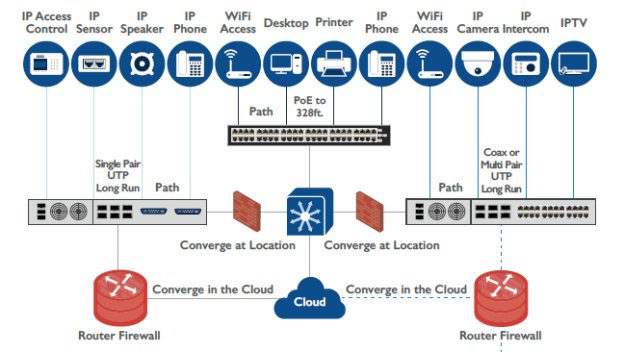Network Solution Services
The Internet of Things (IoT) is changing everything with regard to the modern LAN, as Frost & Sullivan reported in an infographic. As the infographic shows, as enterprises embrace IoT, top challenges surface:
- 49% of enterprises consider security and privacy to be their highest concern
- 39% worry about the cost of integration
- 36% want the time to develop solutions to be faster
The Traditional LAN
The traditional LAN connection endpoints use 4-pair category five or better copper wire. It is limited in distance to about 330 feet or 100 meters. Before the advent of the IP phone, a main concern was how much bandwidth could a PC access on the LAN. LANs started off at 10 Mb, then evolve to 100 Mb, and finally to 1 Gb. The primary design goals were for supporting connected PCs, printers, and scanners. The traditional LAN was not designed for a large quantity of endpoints, nor for bandwidth requirements like the IP phone. IP phones do not require a lot of bandwidth but require quality of service and consistent bandwidth for their operation. This is quite different than the bursty traffic normally encountered with PCs. The traditional LAN has to be reconsidered and redesigned to support the wide range of new devices encountered with IoT and the workplace of the future.
The Modern LAN
The LAN endpoint population has grown in quantity and diversity. LANs must now support IoT, IP phones, video, security systems, and TV, as well as more connections. The number of connections has or will exceed the PC/workstation population in most enterprises. The newer endpoints will be further away than can be supported by traditional 4-pair data quality cable. It may even be connected using coaxial cable. Smarter endpoints need a smarter LAN.

”The Modern LAN: Rethinking Network Design for the Modern Age,” is a useful white paper authored by Frost & Sullivan’s industry experts. The document provides consultants, resellers, and modern enterprises with a revolutionary set of new best practices to accommodate the impact of the Internet of Things on the local area network.
John Croce and I discussed the six LAN design principles as outlined in the Frost & Sullivan paper. These principles will overcome traditional barriers to IP devices and the IoT, and establish a network capable of supporting IoT objectives today and into the future. The following is a digest of our conversation.
Principle 1: Outside Looking In
Look at the endpoints rather than the features and functions of the LAN switch. Adopt an “outside-in” approach to network design. Start with the “things” of the Internet of Things and non-PC devices. Identify the characteristics and requirements of each unique physical device. Determine the topology and infrastructure by incorporating each endpoint’s power, bandwidth, and application requirements.
Principle 2: Design for Security and Management
Simplify LAN management and minimize the core network breach risk. Create a robust and secure local area network that is easy to configure, deploy, manage, and troubleshoot. Ensure convergence flexibility by allowing for separate on-premises or cloud-based unification.
Principle 3: Maximize Efficiencies and Reduce Complexity
Maximize efficiencies by utilizing all technological advancements and innovations to:
- Minimize implementation costs
- Reduce network complexity, making it easier to implement and troubleshoot
- Accelerate modernization so new endpoints can be added
- Eliminate disruption to existing users
Principle 4: Deliver Environmentally Superior Solutions
Modernize to IP endpoints using proven and reliable environmentally responsible frameworks, such as IoTG which measures the environmental impact of the digital transformation process and LEED (Leadership in Energy and Environmental Design certification). Wherever possible, re-use and re-purpose existing endpoint cabling infrastructure. Supporting longer cables can reduce the number of wiring closets (IDF). Use energy efficient PoE switches to reduce IDF closet requirements and e-waste.
Principle 5: LAN Separation
Construct physically separate but functionally integrated IP network paths for different and dedicated applications. Ensure mission-critical platforms are not impacted by disruptions or intrusions into the IoT network.
Principle 6: Reallocate Resources for ROI
Expand sustainable ROI by reallocating resources gained from efficient infrastructure design into enhancing communications-enabled business processes. This reduces infrastructure investment, leaving more budget for new endpoints and applications.
Taking a different approach — “outside looking in” — should include environmental needs, security concerns, and end-user requirements. Enterprises can easily take advantage of transformational technologies and create a framework to embrace completely new solutions today that will work tomorrow.